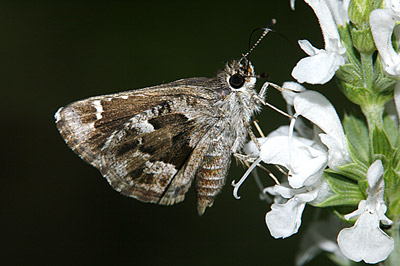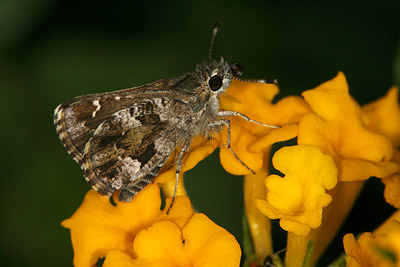|
Nysa Roadside-skipper (Amblyscirtes nysa) |
 |
 |
|
Nysa Roadside-skipper (Amblyscirtes nysa) |
 |
 |
| County | State | Date | County | State | Date | |||
| Oklahoma | OK | 07/2006 | Oklahoma | OK | 06/2006 |
Identification: Fringes are checkered black and white. Upperside is
black with 3-5 small white spots on the
forewing tip. Underside of
hindwing is
patterned with patches of brown, gray, and black.
Life history: Adults fly very close to the ground and often
rest on bare spots. Males perch at the bottom of gulches to await receptive
females. Females lay eggs randomly on the host plants, usually in the late
afternoon. Caterpillars eat leaves and make shelters of rolled and tied leaves,
then pupate in a silk-lined leaf case in litter at the base of a grass clump.
Flight: Three broods from March-October; several broods
throughout the year in South Texas.
Wing span: 3/4 - 1 3/16 inches (1.9 - 3 cm).
Caterpillar hosts: Various grasses including St. Augustine grass (Stenotaphrum
secundatum), crab grass (Digitaria sanguinalis), bristlegrass (Setaria glauca),
barnyard grass (Echinochloa pungens), and green spangletop (Leptochloa dubia).
Adult food: Nectar from low-growing flowers including blue spiraea,
marigold, lima bean, and cantaloupe.
Habitat: Open areas including dry rocky ravines, woodland edges, desert
grasslands, yards, and gardens.
Range: Southeastern Nebraska, Kansas, and western Missouri; south through
Oklahoma and Texas to northern Mexico; west to southeast Colorado, southern New
Mexico, and southern Arizona.